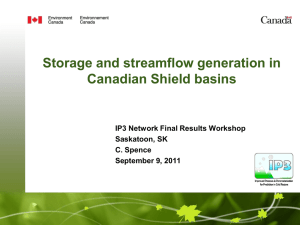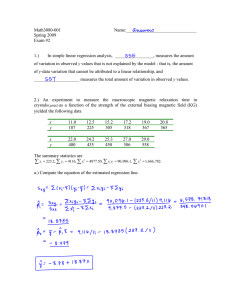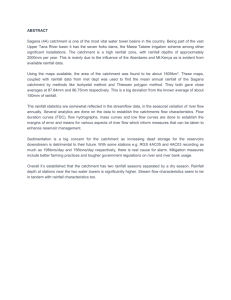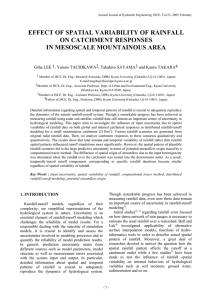A Summary of IP3 Research in the Subarctic Canadian Shield Yellowknife, NWT
advertisement
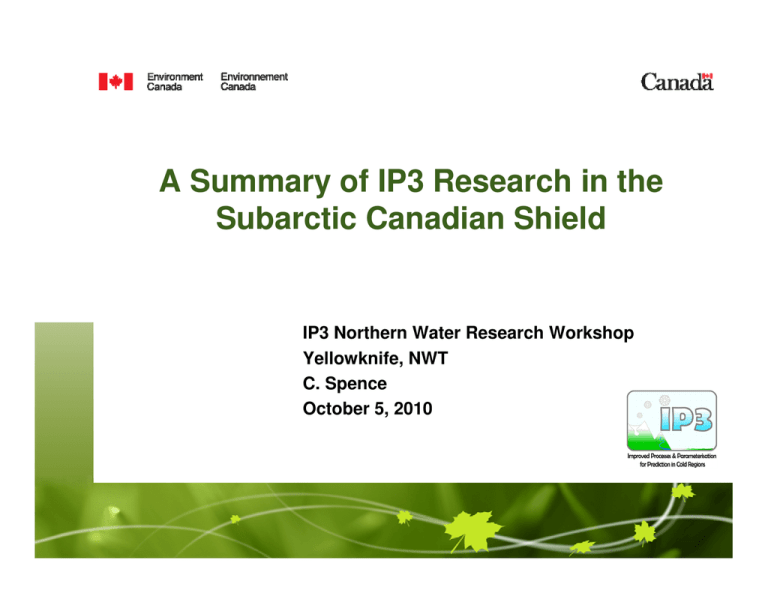
A Summary of IP3 Research in the Subarctic Canadian Shield IP3 Northern Water Research Workshop Yellowknife, NWT C. Spence October 5, 2010 Acknowledgements • NHRC - Newell Hedstrom, • • • • • Raoul Granger, Kelly Best U of S – Xiu Juan Guan, Ross Phillips, Amanda Burke, Jason Hosler, Kirby Ebel INAC - Bob Reid, Meg McCluskie, Shawne Kokelj, Steve Kokelj WSC - Dale Ross, Murray Jones, Dave Helfrick, Jamison Romano, Dwayne Ofukany, Laurie McGregor, Colin McCann, Brian Yurris GSC – Mike Demuth AGRG – Chris Hopkinson DRAFT – Page 2 – November 22, 2010 Headwaters bedrock wetland forested 4 6 1 1 upper bedrock 2 lower bedrock 3 lower forest 4 upper forest 5 lower wetland 6 upper wetland 5 2 3 Spence and Woo, 2006 Woo and Mielko, 2007 DRAFT – Page 3 – November 22, 2010 Baker Creek • The Baker Creek Research • • • • DRAFT – Page 4 – November 22, 2010 Basin drains runoff from ~155 km2 (~170 km2 at the mouth). It is located in the Great Slave High Boreal Ecoregion and Slave Structural Province of the Precambrian Canadian Shield. Land cover is dominated by exposed bedrock (40% of basin area) with substantial portions of wetlands (16%) and coniferous forest (21%). There are 349 lakes in the basin that occupy 23% of the area. Permafrost is discontinuous; absent from bedrock, well drained areas and water courses. HRU scale mPe = a b mPe = 0.0004 mPe = 0.09 Q gw Q gs + Q gp c mPe = 1.1 Guan et al, 2010 DRAFT – Page 5 – November 22, 2010 HRU scale Lake 690 s os M Spence et al, 2010 k ee Cr Climate tower Piezometers and wells Ablation line Soil moisture, temperature Streamflow W9 W7 Vital Lake N 50 0 m 100 DRAFT – Page 6 – November 22, 2010 Lake dominated watercourses Ri + Qi E S2 S1 P L2 A L1 Q = f ( S ) = f ( L, A) if dQ dS dL =0 = 0 and =0 then dt dt dt when P + Ri > E + (Qo − Qi ) , dS >0 dt Ro+Qo Qo DRAFT – Page 7 – November 22, 2010 Lake dominated watercourses DRAFT – Page 8 – November 22, 2010 Spence, 2006 Upscaling to the catchment • Prior to IP3 the influence of small scale storage processes on catchment scale runoff response had not been fully investigated. • The objective of much of the IP3 efforts in Baker Creek was to determine how small scale processes upscaled to the catchment, and evaluate their significance and potential influence on runoff generation. DRAFT – Page 9 – November 22, 2010 Storage measurements DRAFT – Page 10 – November 22, 2010 Storage dynamics over space DRAFT – Page 11 – November 22, 2010 Catchment scale DRAFT – Page 12 – November 22, 2010 Catchment scale DRAFT – Page 13 – November 22, 2010 Characteristic S-Q catchment curves S = 3.28 ⋅ 106 ⋅ ln(Q) + 1.9 ⋅ 107 S = 2 ⋅ 106 exp 2.7285Q DRAFT – Page 14 – November 22, 2010 adapted from Spence et al, 2010 Remote sensing of contributing areas August, 2009 May, 2009 DRAFT – Page 15 – November 22, 2010 Remote sensing of contributing areas DRAFT – Page 16 – November 22, 2010 Connectivity CE ,O Ec = Ep DRAFT – Page 17 – November 22, 2010 Connectivity Phillips et al, 2010 DRAFT – Page 18 – November 22, 2010 Prediction - CRHM 6 5 modelled observed snowmelt and rainfall 40 35 3 Streamflow @ Lower Martin (m /s) s 45 4 30 25 3 20 2 15 10 1 5 0 15-Apr-08 15-May-08 14-Jun-08 14-Jul-08 DRAFT – Page 19 – November 22, 2010 13-Aug-08 12-Sep-08 0 12-Oct-08 Rainfall and snowmelt (mm) on_hru.shp s Changing hydrologic regime 3 Percentage of annual basin yield May – June Sept. – February 1972 to 1982 1983 to 1995 1996 to 2009 70% 80% 50% 12% 6% 39% 3 Mean daily Streamflow (m /s) 2.5 1983 to 1995 1996 to 2009 1972 to 1982 2 1.5 1 0.5 0 1-Jan 1-Mar 30-Apr– Page 20 –29-Jun 28-Aug DRAFT November 22, 2010 27-Oct 26-Dec Regional scale changes 180 20 160 140 Mean daily streamflow (m3/s) Mean daily streamflow (m /s) 18 16 1983 to 1995 1996 to 2009 Snare 3 1983 to 1995 1996 to 2009 14 120 100 80 60 40 12 20 0 1-Jan 10 1-Mar 30-Apr 29-Jun 28-Aug 8 6 4 2 0 1-Jan Cameron 1-Mar 30-Apr 29-Jun 28-Aug DRAFT – Page 21 – November 22, 2010 27-Oct 26-Dec 27-Oct 26-Dec Ecosystem implications DRAFT – Page 22 – November 22, 2010 Summary • New parameterization: 1) the “Guan” number incorporates the relative influence of topology and advective heat on frost table depth and, in turn, hillslope storage capacity. 2) there are characteristic catchment storage-discharge curves. 3) connectivity is related to streamflow and controls the runoff ratio • Model testing continues with representation of response • units reflective of observed hydrological behaviour. This knowledge could be important as changing hydrological regimes in the region test decision making ability. DRAFT – Page 23 – November 22, 2010 Fall runoff events 200 Seasonal rainfall Threshold ~ 110 mm 180 160 Event rainfall R/P = 0.51 Rainfall (mm) 140 120 100 80 60 40 20 0 0 20 40 60 80 100 120 Runoff (mm) 140 160 DRAFT – Page 24 – November 22, 2010 180 200 Precipitation trends - Annual 450 Z statistic = 1.27 P value = 0.2 400 Annual rainfall (mm) 350 300 250 200 150 100 50 0 1970 1975 1980 1985 199022, 2010 1995 DRAFT – Page 25 – November 2000 2005 2010 Precipitation trends - September 120 Z statistic = 2.03 P value = 0.04 Monthly rainfall (mm) 100 80 60 40 20 0 1970 1975 1980 DRAFT –1985 1990 1995 Page 26 – November 22, 2010 2000 2005 2010 Precipitation trends - October 100 Z statistic = -2.31 P value = 0.02 90 Monthly rainfall (mm) 80 70 60 50 40 30 20 10 0 1970 1975 1980 DRAFT –1985 1990 1995 Page 27 – November 22, 2010 2000 2005 2010 Fraction of rain 1 Fraction of rain in precipitation 0.9 Sept. 0.8 0.7 0.6 0.5 0.4 Oct. 0.3 0.2 0.1 0 1980 1985 DRAFT – Page 28 – November 1990 1995 22, 2010 2000 2005 2010 Frequency of exceedance 200 180 Seasonal rainfall (mm) 160 140 120 100 80 60 40 20 0 1980 1985 DRAFT 1990– Page 29 – November 1995 22, 2010 2000 2005 2010


